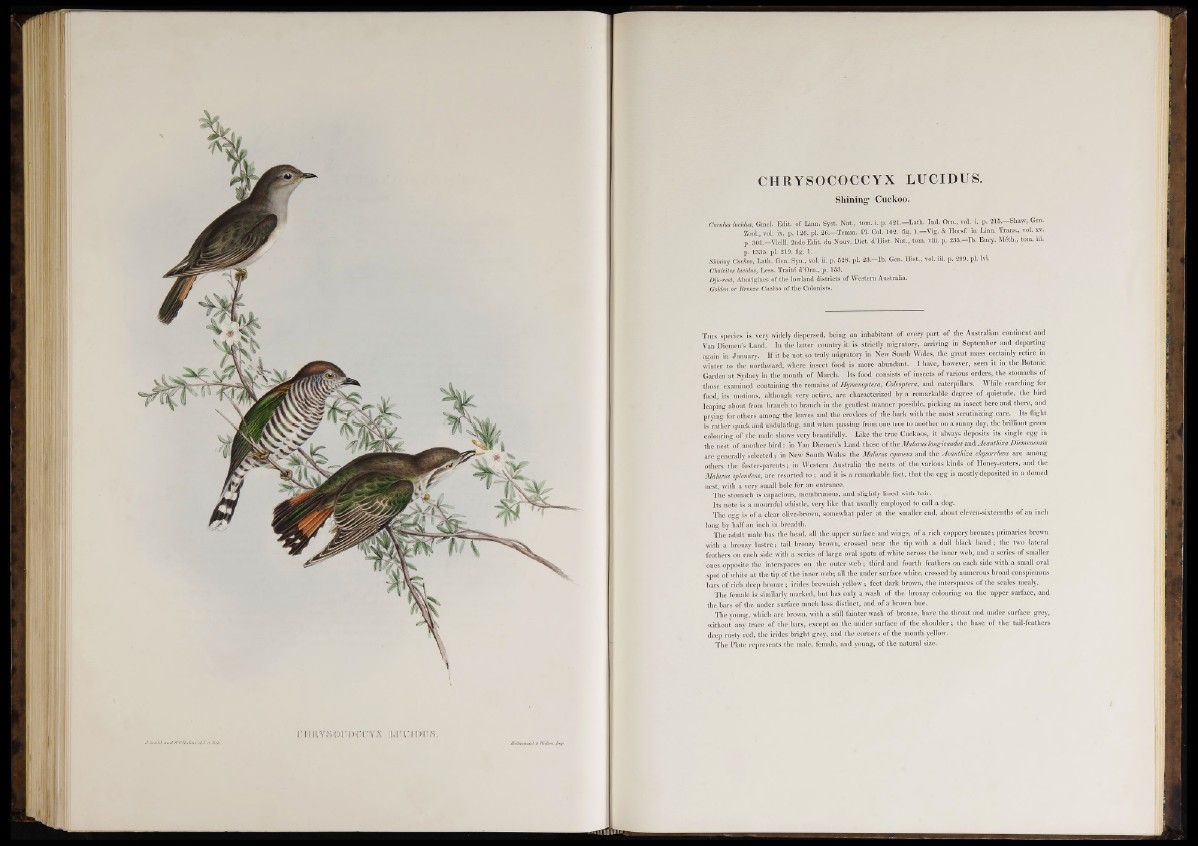
CHRYSOCOCCYX LUCIDUS.
Shining’ Cuckoo.
Cuculus htcidus, Gmd. Edit, of Linn. Syst. Nat,,. tom. P- dSlïpLath. Ind. O n , yol. i. p. 215.—Shaw, Gen.
Zool., -vol. ix. p. 126. pi. 26.—Temm. PI. Col. 102. âg, 1.—Vig. & Horsf. in Linn. Trans., vol. xv.
p. 301. Vieil!. 2nde Edit, du NoUv. Diet. d’Hist. Nat., tom. viii. p. 233.—Ib. Ency. Méth., tbm. iii.
p. 1335. pi, 2M fig. 1.
Shining Cuckoo, Lath. Gen. Syn., vol. ii. p. 528. pi. 23.—Ib. Gen. Hist., vol. iii. p. 299, pi. IvL
Chalcites htcidus, Less. Traité d’Om., p. 153.
DjU-reet, Aborigines of the lowland districts of Western Australia.
Golden or Bronze Cuckoo of the Colonists.
T h is species is very widely dispersed, being an inhabitant o f every part o f the Australian continent and
Van Diemen’s Land. In the latter country it is strictly migratory, arriving in September and departing
again in January. If it be not so truly migratory in New South Wales, the great mass certainly retire in
winter to the northward, where insect food is more abundant. I have, however, seen it in the Botanic
Garden at Sydney in the month of March. Its food consists of insects of various orders, the stomachs of
those examined containing the remains of Hymenoptera, Coleoptera, and caterpillars. While searching for
food, its motions, although very active, are characterized by a remarkable degree of quietude, the bird
leaping about from branch to branch in the gentlest manner possible, picking an insect here and there, and
prying for others among the leaves and the crevices of the bark with the most scrutinizing care. Its flight
is rather quick and undulating, and when passing from one tree to another on a sunny day, the brilliant green
colouring of the male shows very beautifully. Like the true Cuckoos, it always deposits its single egg in
the nest of another bird: in Van Diemen’s Land those of the Malwrm longicimdm and Acanthitsa Diemenemis
are generally selected; in New South Wales the Malurus mjancus and the Acanthka chjsorrhwu are among
others the foster-parents; in Western Australia the nests of the various kinds o f Honey-eaters, and the
Malurm splendent, are resorted to ; and it is a remarkable feet, that the egg is mostly deposited in a domed
nest, with a very small hole for an entrance.
The stomach is capacious, membranous, and slightly lined with hair.
Its note is a mournful whistle, very like that usually employed to call a dog.
The egg is of a clear olive-brown, somewhat paler at the smaller end, about eleven-sixteenths o f an inch
long by half an inch in breadth.
The adult male has the head, all the upper surface and wings, of a rich coppery bronze; primaries brown
with a bronzy lustre; tail bronzy brown, crossed near the tip with a dull black band; the two lateral
feathers on each side with a series of large oval spots of white across the inner web, and a series of smaller
ones opposite the interspaces on the outer web ; third and fourth feathers on each side with a small oval
spot of white at the tip of the inner web; all the under surface white, crossed by numerous broad conspicuous
bars of rich deep bronze; irides brownish yellow; feet dark brown, the interspaces of the scales mealy.
The female is similarly marked, but has only a wash of the bronzy colouring on the upper surface, and
the bars of the under surface much less distinct, and o f a brown hue.
The young, which are brown, with a still fainter wash of bronze, have the throat and under surface grey,
without any trace of the bars, except on the under surface of the shoulder; the base o f the tail-feathers
deep rusty red, the irides bright grey, and the corners of the mouth yellow.
The Plate represents the male, female, and young, of the natural size.